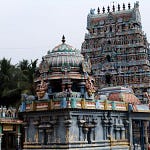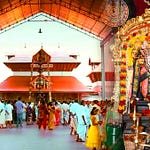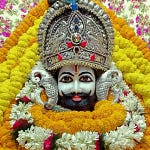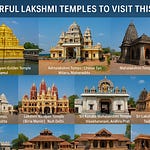Tucked away in the rugged terrains of Ladakh, surrounded by the snow-capped Himalayan ranges and windswept landscapes, Likir Gompa rises with quiet majesty as one of the oldest and most spiritually revered Buddhist monasteries in northern India. With its roots tracing back nearly a millennium, this sacred site offers more than just breathtaking views—it’s a profound seat of learning, practice, and devotion for Tibetan Buddhism. It is here that time seems to slow down, inviting devotees and seekers to dive into an ocean of spiritual heritage, ancient rituals, and mystical tales.
Origins and Historical Foundation
The name “Likir” comes from the Tibetan word ‘Lu-Khyil’, meaning "The Naga Encircled," symbolizing the protection of the site by the mythical serpent spirits or nagas. This spiritual symbolism points to the mystical aura that has surrounded the monastery since its foundation.
Likir Monastery was established in 1065 AD during the reign of King Lhachen Gyalpo, the fifth monarch of Ladakh. Initially affiliated with the Kadampa school of Tibetan Buddhism—an older sect founded by Atisha in the 11th century—the monastery later came under the influence of the Gelugpa (Yellow Hat) order, established by the great reformer Tsongkhapa in the 15th century. This transformation was guided by Lama Lha-dbang-chos-rje, a key figure who realigned the monastery’s practices with the Gelug tradition while preserving its deep-rooted philosophies.
Throughout centuries, Likir Gompa has survived invasions, harsh winters, and the test of time, emerging not only as a place of spiritual pursuit but also as a historical archive of Ladakhi art, architecture, and religious expression.
Architectural Grandeur and Monastic Complex
Perched on a hillock at an altitude of about 3,700 meters (12,100 feet), the monastery overlooks the lush Likir valley and offers expansive views of the Himalayan wilderness. The architectural design reflects classical Tibetan styles, with whitewashed walls, prayer halls adorned with intricate murals, vibrant thangkas (Buddhist scroll paintings), and multicolored wooden carvings.
One of the most awe-inspiring sights is the 23-meter-high statue of Maitreya Buddha (Future Buddha), installed in 1999. Gold-gilded and seated in a meditative posture against the backdrop of vast mountains, the statue captures the spirit of compassion, wisdom, and hope for the future. This imposing structure stands tall as both a modern marvel and a continuation of age-old devotion.
Inside the monastery, visitors will find:
The Dukhang (main assembly hall), adorned with murals of deities and Buddhist guardians.
Shrines dedicated to Tsongkhapa, Avalokiteshvara, and other Bodhisattvas.
A library of ancient scriptures, including hand-written Buddhist texts in Tibetan and Sanskrit.
Meditation rooms and residential quarters for the monks.
Rituals, Puja, and Daily Monastic Life
Likir Gompa is a living monastery, home to over 120 monks who carry forward centuries-old rituals and spiritual practices. The monastery follows a strict schedule of daily pujas (prayer ceremonies), meditation sessions, and monastic education.
Morning puja begins at dawn with the blowing of long copper horns and chanting of sacred mantras. Monks offer prayers to deities, perform rituals with butter lamps, incense, and tsampa (roasted barley), and engage in recitations of scriptures. Chöd rituals, Mahamudra meditations, and Mandala offerings are part of the more advanced practices reserved for senior monks.
A notable celebration is the Dosmochey Festival, held annually around February, during which monks perform Cham dances—masked dances symbolizing the victory of good over evil. These dances are more than cultural displays—they are tantric rituals believed to purify the environment and ensure peace and prosperity for the region.
What to Do When Visiting Likir Gompa
Visitors to Likir are encouraged to immerse themselves respectfully in the monastic rhythm. Here’s what can make your experience spiritually enriching:
Attend a morning or evening puja to witness authentic Tibetan Buddhist rituals.
Meditate in silence within the temple premises—many visitors find the monastery’s energy calming and transformative.
Engage with resident monks, many of whom are happy to share stories and insights into Buddhist teachings.
Walk clockwise (kora) around the prayer wheels and stupas, spinning them mindfully as you chant mantras like “Om Mani Padme Hum.”
Explore the monastic school, where young monks learn scriptures, grammar, philosophy, and dialectics.
Take in the valley’s serenity from the terrace of the monastery—it’s a moment to reflect, pray, or simply absorb the peaceful vibrations of the place.
What Not to Do
Likir Gompa is a sacred site, not just a tourist spot. Visitors should be mindful of local customs and religious decorum:
Do not wear revealing clothes; dress modestly, covering arms and legs.
Do not touch sacred objects or statues unless explicitly permitted.
Avoid loud talking, music, or disruptive behavior, especially during prayer times.
Refrain from taking photographs inside temples, unless allowed.
Do not step over prayer books or sacred offerings.
Do not point your feet toward the altar while sitting or meditating.
Religious Importance and Spiritual Significance
Likir Monastery is more than just bricks and scriptures—it is a living spiritual sanctuary that upholds centuries of Buddhist wisdom. To the followers of Tibetan Buddhism, it symbolizes:
Protection and healing (as signified by the nagas encircling the gompa).
A path of discipline and compassion, as espoused by the Gelugpa teachings.
A place for accumulating merit through prayers, offerings, and selfless service.
A hub for preservation of Tibetan Buddhist culture through education and rituals.
For devotees, coming to Likir Gompa is akin to returning home. It serves as a spiritual compass that aligns the mind and heart with dharma (righteousness). Many pilgrims come here to seek guidance, blessings, or simply to rekindle their inner light.
Mysteries and Legends
Legend holds that Likir is protected by the nagas, mystical serpent deities believed to dwell beneath sacred mountains and rivers. These beings are said to guard holy sites and bestow blessings upon those who approach with pure hearts. Monks recount tales of visions and dreams where spirit protectors revealed themselves, urging the community to maintain the sanctity of the site.
There are also stories of hidden treasures, blessed relics, and oracles who once resided here, channeling divine messages during festivals and critical periods.
Travel and Visit Information
How to Reach:
From Leh, Likir Gompa is about 52 kilometers west. A scenic drive via NH1 (Srinagar-Leh highway) takes approximately 1.5 to 2 hours by taxi or rented vehicle.
Regular shared taxis are available from Leh, and the route is part of the popular Sham Valley circuit.
Best Time to Visit:
May to September offers ideal weather, with clear skies and pleasant temperatures.
The Dosmoche Festival in February is also a magical time, but be prepared for biting cold.
Nearby Attractions:
Alchi Monastery, famous for its 11th-century Indo-Tibetan art.
Basgo Palace, known for its historical ruins and commanding views.
The Indus River, ideal for nature walks and riverside meditation.
In the Life of a Devotee
For many Buddhists and spiritual seekers, a journey to Likir is a pilgrimage of transformation. Devotees often spend days or weeks here, performing prostrations, engaging in retreats, or simply volunteering to serve the monastery.
To a devotee, Likir is:
A shelter from worldly noise.
A place to deepen faith and rekindle vows.
A ground to reflect on impermanence, practice mindfulness, and seek liberation.
It reminds us that in the fleeting journey of life, certain places become bridges to the eternal—and Likir Gompa is one such bridge.
Likir Gompa is not just a monastery—it is a spiritual echo from the past, resonating with timeless teachings of compassion, discipline, and inner peace. Whether you are a pilgrim on a sacred journey, a wanderer in search of meaning, or a curious traveler, Likir embraces you with its silent chants, fragrant incense, and centuries-old wisdom. In its stillness lies the heartbeat of Ladakh’s Buddhist soul.










